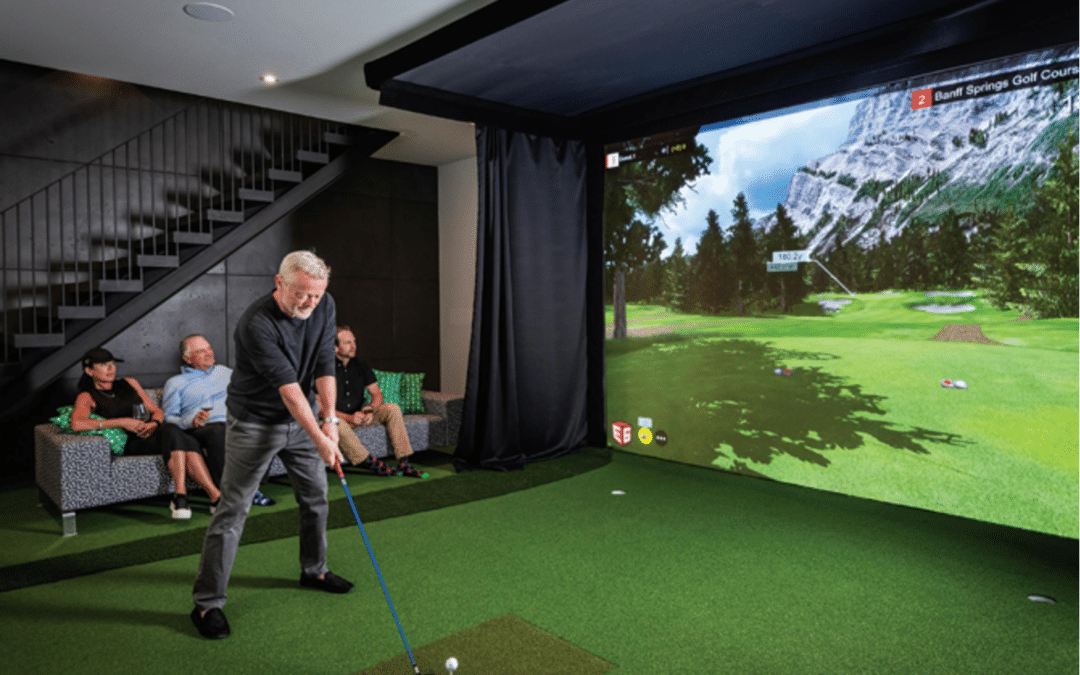Indoor golf is as competitive as it’s ever been while many of the biggest companies in the game have also been recipients of record growth over the past four-plus years. It’s all a good problem to have for those with skin in the indoor game.
Rene Delgado, founder and CEO of The Indoor Golf Shop, the leading online retailer, distributor and manufacturer of indoor golf products, never dreamed his company would see so much growth so quickly when he launched the Texas-based business back in 2017. Today TIGS resides in 50,000 square feet of space north of Dallas with a luxury showroom, dubbed “The Cabin,” opening later this summer.
“Since COVID, there’s been this huge influx of interest in all things golf,” Delgado said. “Indoor golf in particular really saw hockey-stick growth during COVID and shortly thereafter. We’re starting to see some normalization this year. We’re still seeing decent growth but at a tamer level than before.
“The industry has evolved a lot since 2020. There used to be a handful of players that had golf simulator technology, launch monitor technology, and we’re seeing so many new entrants into the space. In terms of options, there are tons and tons of options for golfers – economical, mid-range and in the high-end luxury space.”
TECHNOLOGY HAS OPENED THE FLOODGATES
One of the reasons for such popularity is because of evolving technology. When that happens, Delgado said, affordability starts to become more reasonable and it’s not particularly necessary to purchase a simulator for a home or business that tops $20,000. In some cases, consumers can now buy a basic setup with a launch monitor, mat and net for under $1,000 and scale up their simulator buildouts in seemingly endless ways. Technology breeds accessibility.
“We’re starting to see a change in consumer behavior for the direct-to-consumer market,” Delgado said. “Information is now more readily available. Consumers are much more savvy and very value-driven. The luxury market remains strong and agnostic toward cost. But the foundation, the mid-market, they’re getting much more savvy as consumers.”
MEETING MARKET DEMAND WITH CREATIVE SOLUTIONS
Delgado and his team problem-solved a huge issue during the pandemic, which ultimately opened more revenue streams. Because of global supply chain issues a few years ago, his company left no stone unturned in finding a way to better control their own destiny and better support their customers.
The solution? The Indoor Golf Shop doubled down on manufacturing and figured out a way to mass produce products critical to quality sim buildout.
“We looked at everything,” Delgado said. “We decided to become a reliable manufacturer of soft goods – premium impact screens, golf mats, simulator flooring, and more.”
“We manufacture our own enclosures and structures for both residential and commercial installations. It’s lowered our cost basis, but it’s also allowed us to rapidly react to what consumers are looking for.”
DEMYSTIFYING THE BUYING AND INSTALLATION PROCESS
With supply no longer an issue, TIGS was then able to focus completely on the consumer. When a customer approaches the company, the first thing TIGS asks is about specific goals. In order to steer them in the proper direction they need to know if the system will be for game improvement, training, entertainment or a combination of both. Will it be for both right-handed and left-handed golfers? What is the overall objective?
“It’s all about understanding the motivation behind a customer’s want of a simulator,” Delgado said. “Then, based on that and their situation, we can educate them based on the best options.”
There is something for everyone, no matter the purpose.
“You have entry-level, and those types of consumers usually want something basic, which means a piece of turf, a hitting net and an entry-level launch monitor, something they can hook up their iPad to and see their data displayed but not have to spend thousands of dollars.
“Then you have those who want full-blown simulation where they’re hitting the ball into the screen in front of them. There are two kinds of those customers; There are DIY type individuals who want to buy the components from you and build out their own space. Then there are people like me that want everything curated, a sim-in-a-box type customer. Historically that’s been our biggest line. We provide them with the best technology, hitting mats, screens, turf, put it all on a palette, and ship it to their doorstep.
“Then there is the high-end custom design and build demographic. These customers go through a completely different buying process that is much more involved. We take them through an elaborate design phase, oftentimes working hand in hand with their own designers and architects. Customers have an opportunity to review 2D/3D drawings showing them exactly what their space will look like ahead of time. We then move into the production phase where the team manufactures the custom components. The last step is the installation – where we fly out a team of our certified golf sim installers to perform the install for the customer.”
While all three businesses have been prosperous for Delgado, they each have been more popular at different times. Until recently, the sim-in-a-box concept was the biggest seller. This year, they’re selling standalone components at a much faster rate than all-inclusive components.
“Some can feel overwhelmed by the process because there’s so much out there,” Delgado said. “Before there used to only be a couple of options. Now you can get analysis paralysis. That’s where we come in and provide the value add and educating and steering customers into the right options for them.”
WHAT’S NEXT?
The evolution of indoor golf simulation has come so far so quickly, that it’s difficult to predict where it will be in the near future. Even within a year. Artificial intelligence is slowly making its way into the space, just as it is with everything else in the world. Multi-sport technology is getting better, where players can play baseball, hockey, soccer or other sports on the same simulator. Things are becoming commonplace now that were unimaginable just a couple years ago. The trend will continue.
It’s likely that there will be other changes too, although it’ll be more on the business side.
“I think the industry in general will see some consolidation in the space; some players exiting, others being acquired,” Delgado said. “By early next year, the players and manufacturers will look different than they do today. But for consumers it’s only going to continue to get better.
“The golf league next year [TGL], I’m really excited about that. That’s going to expose a ton of people to the game who have not otherwise been exposed to it. And the technology is going to continue to improve. May not seem like it, but it absolutely will.”
Special to Spikeongolfandtravel.com
Photo Courtesy of The Indoor Golf Shop

